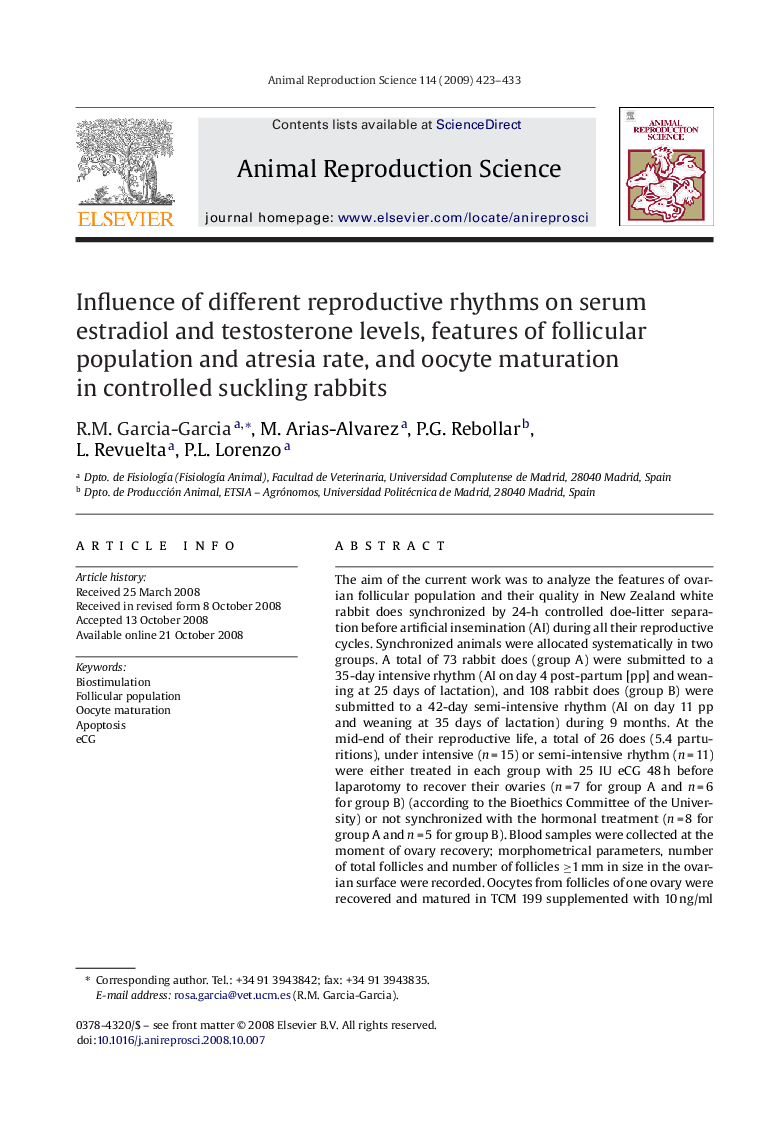| کد مقاله | کد نشریه | سال انتشار | مقاله انگلیسی | نسخه تمام متن |
|---|---|---|---|---|
| 2074269 | 1079081 | 2009 | 11 صفحه PDF | دانلود رایگان |

The aim of the current work was to analyze the features of ovarian follicular population and their quality in New Zealand white rabbit does synchronized by 24-h controlled doe-litter separation before artificial insemination (AI) during all their reproductive cycles. Synchronized animals were allocated systematically in two groups. A total of 73 rabbit does (group A) were submitted to a 35-day intensive rhythm (AI on day 4 post-partum [pp] and weaning at 25 days of lactation), and 108 rabbit does (group B) were submitted to a 42-day semi-intensive rhythm (AI on day 11 pp and weaning at 35 days of lactation) during 9 months. At the mid-end of their reproductive life, a total of 26 does (5.4 parturitions), under intensive (n = 15) or semi-intensive rhythm (n = 11) were either treated in each group with 25 IU eCG 48 h before laparotomy to recover their ovaries (n = 7 for group A and n = 6 for group B) (according to the Bioethics Committee of the University) or not synchronized with the hormonal treatment (n = 8 for group A and n = 5 for group B). Blood samples were collected at the moment of ovary recovery; morphometrical parameters, number of total follicles and number of follicles ≥1 mm in size in the ovarian surface were recorded. Oocytes from follicles of one ovary were recovered and matured in TCM 199 supplemented with 10 ng/ml EGF, 100 ng/ml IGF-I and 10% FCS. The counterpart ovaries were fixed in paraformaldehyde solution for histological studies. Detection of cell apoptosis was determined using the terminal deoxynucleotidyl transferase-mediated dUTP nick-end-labelling (TUNEL) technique. Reproductive performance was affected by the rhythm used, with lower reproductive parameters in the intensive group. The average ovary height and width, the mean number of ≥1 mm follicles and the number of total follicles were similar between groups. Serum concentrations of estradiol (E2) and testosterone (T) were significantly lower in group A vs. B (E2: 232.4 ± 56.1 vs. 399.7 ± 53.0 pg/ml; P < 0.05 and T: 1.07 ± 0.10 vs. 1.68 ± 0.23 ng/ml; P < 0.05). No significant differences were found in follicular population or in the mean follicular apoptosis index between groups. Metaphase II rate was significantly lower in group A vs. B (48.5 ± 3.3 vs. 67.6 ± 3.7%; P < 0.01), as well as the migration rate of cortical granules (12.7 ± 2.7 vs. 38.2 ± 6.6%; P < 0.001). On the other hand, neither follicular population, nuclear maturation rate nor apoptosis rate were affected by the eCG treatment, but cytoplasmic maturation was higher in animals treated with eCG in group A (29.2% vs. 5.5%; P < 0.01). In conclusion, rabbit does under transient litter separation during their reproductive life have both their serum estradiol and testosterone concentrations and oocyte quality influenced by the intensive rhythm, leading to a decrease in reproductive parameters. Also, both intensive and semi-intensive rhythms seem to be less receptive to eCG treatment than expected.
Journal: Animal Reproduction Science - Volume 114, Issue 4, September 2009, Pages 423–433